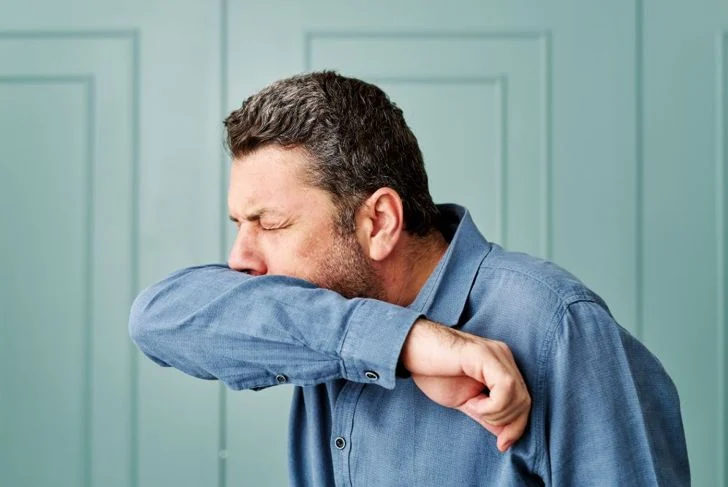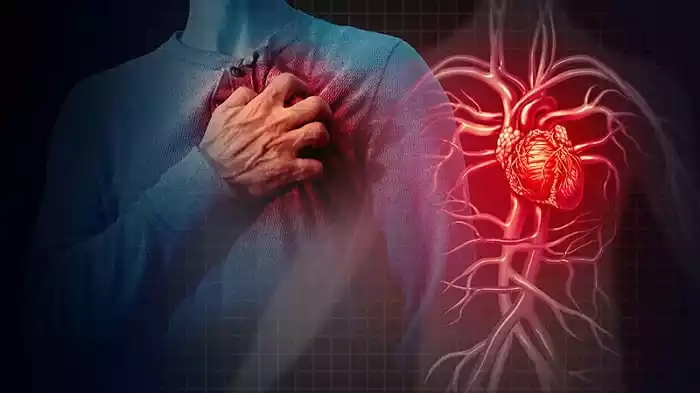Orthopnea and PND are two conditions characterized by breathlessness, particularly during sleep. While Orthopnea is experienced when lying down, PND involves sudden awakenings due to severe shortness of breath. The causes, symptoms, and management of these conditions, provide insights for those seeking relief from nocturnal breathlessness.
What is Orthopnea?

Orthopnea is a medical condition characterized by a specific pattern of breathing difficulty. People with orthopnea experience significant discomfort and a sensation of breathlessness when they lie flat, such as when they’re trying to sleep in a supine position. This condition is notably relieved when they sit upright or elevate the upper part of their body with pillows.
The fundamental reason behind orthopnea is the redistribution of fluid within the body, particularly in the lungs, when changing positions. When lying down, fluid can accumulate in the lungs, impeding normal airflow and making it challenging to breathe. By assuming an upright position, the gravitational force assists in reducing this fluid accumulation, making breathing easier for individuals with orthopnea.
Orthopnea is often indicative of an underlying medical issue, primarily related to the heart or lungs. It is frequently associated with conditions like congestive heart failure, where the heart struggles to pump blood effectively, leading to fluid retention in the lungs. Various lung disorders, including chronic obstructive pulmonary disease (COPD) and interstitial lung disease, can also cause orthopnea due to impaired lung function. Identifying and addressing the root cause of orthopnea is crucial, and treatment typically involves a thorough medical evaluation, diagnostic tests, and appropriate interventions targeting the underlying condition.
Orthopnea is a distinctive symptom characterized by breathing difficulties when lying flat, alleviated by adopting an upright position. It often points to underlying cardiac or pulmonary problems and necessitates a comprehensive evaluation by healthcare professionals to determine its cause and initiate appropriate treatment measures.
Causes of Orthopnea
Here are the causes of orthopnea:
- Congestive Heart Failure (CHF): Impaired heart function leading to fluid accumulation in the lungs.
- Valvular Heart Disease: Problems with heart valves affecting blood flow and lung fluid.
- Cardiomyopathy: Heart muscle diseases that weaken the heart’s pumping ability.
- Hypertension (High Blood Pressure): Chronic high blood pressure can strain the heart.
- Pulmonary Conditions: Lung diseases like COPD, asthma, and interstitial lung disease.
- Obesity: Excess weight can compress the diaphragm and lungs.
- Fluid Retention: Conditions causing fluid buildup, e.g., kidney or liver disease.
- Pregnancy: Growing uterus can affect lung capacity in later stages.
- Neuromuscular Conditions: Weakness in breathing muscles (e.g., muscular dystrophy).
- Sleep Apnea: Severe obstructive sleep apnea can disrupt breathing when lying down.
Please note that these are common causes, and individual cases may vary. Consulting a healthcare professional for a thorough evaluation is crucial to determine the specific cause of orthopnea and appropriate treatment.
What is PND?

Paroxysmal Nocturnal Dyspnea (PND) is a medical condition characterized by sudden and severe episodes of breathlessness that typically occur during sleep, waking the affected individual with a sensation of suffocation and intense discomfort. These episodes often force the person to sit up or stand to find relief. PND is a distinct type of dyspnea, or difficulty breathing, with the notable characteristic of its nighttime occurrence.
PND is most commonly associated with underlying cardiac issues, particularly congestive heart failure (CHF). In individuals with CHF, the heart’s pumping ability is compromised, leading to fluid accumulation in the lungs. When lying down, the redistribution of this fluid can overload the heart, causing sudden and severe respiratory distress, hence the occurrence of PND during sleep. Other potential causes of PND include valvular heart disease, coronary artery disease, and certain arrhythmias.
Diagnosis of PND typically involves a medical history review, physical examination, and diagnostic tests such as echocardiography and electrocardiography. Managing PND primarily revolves around addressing the underlying cardiac condition through medications, lifestyle modifications (including dietary changes and salt restriction), and sometimes surgical interventions.
It is crucial for individuals experiencing PND to seek prompt medical attention, as it can be indicative of significant heart-related issues that require treatment and management to improve cardiac function and alleviate symptoms.
Causes of Paroxysmal Nocturnal Dyspnea ( PND)
Here are the causes of Paroxysmal Nocturnal Dyspnea (PND):
- Congestive Heart Failure (CHF): The most common cause, where a weakened heart leads to fluid accumulation in the lungs.
- Valvular Heart Disease: Heart valve problems, like aortic stenosis or mitral regurgitation, can cause PND.
- Coronary Artery Disease: Reduced blood flow to the heart muscle can weaken the heart and contribute to PND.
- Arrhythmias: Irregular heart rhythms can affect the heart’s pumping efficiency, potentially leading to PND.
- Hypertension (High Blood Pressure): Chronic high blood pressure can strain the heart, contributing to heart failure and PND.
- Cardiomyopathy: Diseases of the heart muscle can impair the heart’s ability to pump effectively.
- Fluid Retention: Conditions such as kidney or liver disease that cause fluid buildup can worsen PND.
- Excessive Salt Intake: High-salt meals or excessive fluid intake before bedtime can trigger PND in susceptible individuals.
PND is a symptom of underlying cardiac issues, particularly heart failure, so addressing the root cause through medical evaluation and treatment is essential to manage and alleviate PND symptoms.
Diagnosing Orthopnea and PND
Diagnosing Orthopnea
- Medical History: Assessing the patient’s history, particularly their symptoms and any underlying conditions.
- Physical Examination: Evaluating breathing patterns and listening to lung and heart sounds.
- Imaging: Chest X-rays or echocardiography to identify lung or heart issues.
- Pulmonary Function Tests: Assessing lung function to rule out respiratory causes.
- Blood Tests: Checking for signs of heart failure or other relevant markers.
- Electrocardiogram (ECG or EKG): Monitoring heart rhythms and detecting abnormalities.
Diagnosing Paroxysmal Nocturnal Dyspnea (PND)
- Clinical History: Inquiring about nighttime symptoms, especially sudden awakenings due to breathlessness.
- Physical Examination: Assessing respiratory and cardiac function.
- Polysomnography: Sleep study to monitor breathing patterns and detect sleep-related breathing disorders.
- Electrocardiogram (ECG or EKG): To evaluate heart rhythms and potential cardiac causes.
- Echocardiography: Assessing heart function and identifying structural issues.
- Blood Tests: Checking for markers of heart failure or other relevant conditions.
Both conditions may require additional tests and evaluations based on the suspected underlying causes. A thorough assessment by a healthcare professional is crucial for an accurate diagnosis and appropriate treatment.
Managing Orthopnea and PND
Managing Orthopnea:
- Identify the underlying cause (heart, lung issues).
- Take prescribed medications (diuretics, bronchodilators).
- Adopt lifestyle changes (healthy weight, low-sodium diet).
- Sleep with an elevated head.
- Manage underlying conditions (heart or lung issues).
Managing PND:
- Treat the underlying heart condition (medications).
- Use diuretics for fluid reduction.
- Restrict dietary salt intake.
- Sleep with an elevated head.
- Consider CPAP therapy if related to sleep apnea.
- Embrace a heart-healthy lifestyle (exercise, diet, weight control).
Regular medical check-ups are essential for monitoring progress and adjusting treatment plans.
When to Seek Medical Help

Seeking medical help promptly is crucial when experiencing symptoms of orthopnea or PND, as these conditions can be indicative of serious underlying health issues. Here are specific instances when you should seek medical assistance:
- Orthopnea:
- If you experience sudden or severe difficulty breathing when lying flat.
- When orthopnea becomes a persistent or recurrent problem.
- If you have a known heart or lung condition, and your orthopnea worsens or changes in any way.
- When other concerning symptoms accompany orthopnea, such as chest pain, palpitations, or significant weight gain.
- Paroxysmal Nocturnal Dyspnea (PND):
- If you wake up suddenly from sleep gasping for breath or with severe shortness of breath.
- When PND episodes become frequent or increasingly severe.
- If you have a known heart condition or congestive heart failure, and you experience PND.
- When daytime symptoms like persistent cough, fatigue, or swelling of the legs and ankles accompany PND.
Do not delay seeking medical attention if you or someone you know experiences these symptoms. These could be signs of serious cardiac or respiratory issues that require immediate evaluation and treatment by a healthcare professional. Early intervention can greatly improve outcomes and quality of life for individuals with orthopnea or PND.
Comparison table of Orthopnea and PND
Here’s a comparison table of Orthopnea and PND (Paroxysmal Nocturnal Dyspnea):
| Characteristic | Orthopnea | PND (Paroxysmal Nocturnal Dyspnea) |
|---|---|---|
| Definition | Difficulty breathing when lying flat, typically relieved by sitting up or elevating the upper body. | Sudden, severe breathlessness during sleep, often waking the person from sleep. |
| Timing | Experienced when lying down, especially flat. | Primarily occurs during sleep, typically at night. |
| Common Causes | Heart conditions (e.g., heart failure, valve issues), lung problems, obesity, fluid retention. | Congestive heart failure (CHF), cardiac issues, fluid retention. |
| Diagnostic Tools | Clinical assessment, medical history, imaging tests (e.g., X-rays, echocardiography). | Clinical history, sleep studies (polysomnography), cardiac evaluations (ECG, echocardiography). |
| Management | Treat underlying causes, lifestyle changes (e.g., weight management, salt restriction), medications (e.g., diuretics). | Focus on managing CHF or cardiac issues, diuretics, salt restriction, lifestyle adjustments. |
| Key Differentiator | Difficulty lying flat; symptoms occur when awake. | Nighttime breathlessness during sleep, awakening from sleep. |
| Common Underlying Conditions | Heart failure, lung diseases, obesity. | Congestive heart failure (CHF) or heart-related problems. |
Both Orthopnea and PND are symptoms of underlying health issues, and seeking medical evaluation is essential for proper diagnosis and management.
What is the similarities between Orthopnea and PND?
Similarities between Orthopnea and PND:
- Both involve difficulty breathing.
- Linked to underlying heart issues.
- Relief with changes in body position.
- Potential fluid accumulation.
- Diagnosed through similar methods.
Ending
Orthopnea and Paroxysmal Nocturnal Dyspnea (PND) are respiratory symptoms often linked to heart and lung issues. Prompt diagnosis and management are vital for improved quality of life. Treatment involves addressing underlying causes, medications, and lifestyle changes. Regular medical follow-ups are crucial for successful management.



